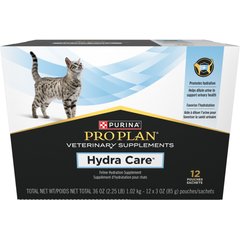Sperm Abnormalities in Cats
Spermatozoal Abnormalities in Cats
Symptoms
Spermatozoal abnormalities are sometimes classified into primary and secondary defects. Primary defects occur during spermatogenesis, the development stage, and secondary defects occur during transport and storage within the epididymis (part of the spermatic duct system). Often there are no outward symptoms of this disorder. The most obvious symptom makes itself apparent in the breeding cat, when the male cat fails to impregnate a breeding partner.
Vet Recommended Health Support
- Feliway Optimum Enhanced Calming 30 Day Diffuser for Cats$29.99Chewy Price
- Purina Pro Plan Veterinary Diets FortiFlora Powder Probiotic Digestive Supplement for Cats, 30 count$30.99Chewy Price
- Purina Pro Plan Veterinary Diets Hydra Care Liver Flavored Liquid Supplement for Cats, 3-oz pouch, case of 12$14.99Chewy Price
- Purina Pro Plan Adult Sensitive Skin & Stomach Lamb & Rice Formula Dry Cat Food, 7-lb bag$28.08Chewy Price
Causes
Congenital
- Primary ciliary (hair-like cells) dyskinesia (difficulty in performing voluntary movements) – an abnormality of the cilia which results in absent or abnormal motility of the ciliated cells; affected animals are infertile; reported in many breeds; probably autosomal recessive inheritance
- Idiopathic (cause unknown) inherent poor sperm morphology
- Testicular underdevelopment – tortoiseshell or calico tom cats
- Excessive inbreeding – inbreeding in domestic cats can result in a significant reduction in the percentage of normal cells within one generation; wild species with loss of genetic diversity experience an increase in teratozoospermia and a reduction in fertility
Acquired
- Conditions disrupting normal testicular thermoregulation (temperature regulation) – trauma; hematocele (swelling due to a flow of blood); hydrocele (collection of fluid in a sac); orchitis (inflammation of the testis); epididymitis (inflammation of the epididymus, the ducts through which the sperm are conveyed); prolonged fever secondary to systemic infections; obesity (increased scrotal fat); inability to adapted to high environmental temperatures; exercise-induced heat exhaustion; seasonal (summer months)
- Infections of the reproductive tract – prostatitis; brucellosis (infectious diseases caused by the bacteria Brucella melitensis); orchitis (inflammation of the testis); epididymitis (inflammation of the epididymus, the ducts through which the sperm are conveyed)
- Drugs
- Testicular cancer
- Prolonged sexual abstinence in a non-neutered male
- Excessive sexual activity
- Testicular degeneration
Diagnosis
You will need to give your veterinarian a thorough history of your cat's health, along with any possible incidents that might have led to this condition, such as trauma, infection, or travel (as other climates, especially hot climates, may have played a role).
A history of your cat's infertility will help your veterinarian to make a diagnosis. For example, has he been infertile after appropriately timed mating to several reproductively-proven queens? Have spermatozoal abnormalities been found during routine breeding soundness evaluation? Your veterinarian will probably do a hormonal profile as well as an examination of the ejaculates (the sperm cells). Your doctor will also test for bacterial infections, and may use visual diagnostic tools to examine the reproductive tract. An ultrasound examination may show whether there is a blockage, orchitis (inflammation of the testis), hydrocele, hemorrhage into a cavity, cyst of the epididymus, or tumor in the testicular region that is affecting the sperm ducts and sperm morphology.
Treatment
There is no a specific treatment for spermatozoal abnormalities; if applicable, the underlying disease or condition will be treated. Antibiotics and anti-inflammatory agents will be prescribed for infectious diseases and swelling due to inflammation. Unilateral surgical removal may be recommended for unilateral testicular tumors or severe orchitis. Your veterinarian may recommend sexual rest for edema (swelling) or for a cyst associated with trauma. Frequent semen collection may temporarily improve sperm quality in cats with idiopathic teratozoospermia, but the quality of the sperm will have to be tested before it is used for breeding purposes, to avoid genetic abnormalities resulting from poor sperm.
If your cat is in an extremely hot environment, or it is the summer season, protect your cat from high ambient temperatures by moving him to a cooler space. In addition, if your cat is highly active, you may need to alter your cat's activity level to reduce heat stress, unless your veterinarian has specifically ordered more exercise for treatment of obesity.
Prevention
It may help to provide a climate-controlled environment for your cat if it is not adapted to high environmental temperatures. Also, avoid heat exhaustion during exercise or grooming (e.g., drying cages).
Living and Management
If an underlying cause is identified and treated, your veterinarian will want to perform a sperm evaluation at 30 and 60 days after the condition is resolved. In cases due to reversible causes, a complete improvement in sperm morphology does not usually occur before 60 days -- the approximate length of a complete spermatogenic cycle.



